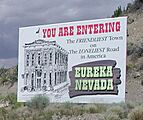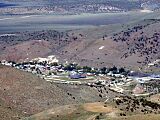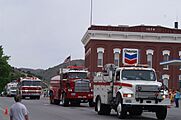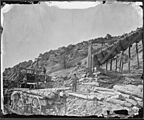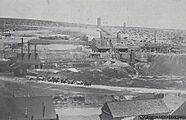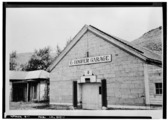Eureka, Nevada facts for kids
Quick facts for kids
Eureka, Nevada
|
|
|---|---|
 |
|
| Nickname(s):
The Friendliest Town on The Loneliest Road
|
|
| Country | United States |
| State | Nevada |
| County | Eureka |
| Area | |
| • Total | 1.29 sq mi (3.35 km2) |
| • Land | 1.29 sq mi (3.35 km2) |
| • Water | 0.00 sq mi (0.00 km2) |
| Elevation | 6,674 ft (2,034 m) |
| Population
(2020)
|
|
| • Total | 414 |
| • Density | 320.43/sq mi (123.71/km2) |
| Time zone | UTC−8 (Pacific (PST)) |
| • Summer (DST) | UTC−7 (PDT) |
| ZIP code |
89316
|
| FIPS code | 32-23900 |
| GNIS feature ID | 2583922 |
Eureka is a small town in Nevada, United States. It's known as an "unincorporated town," which means it doesn't have its own local government like a city. Instead, it's managed by the county. Eureka is also the main town, or "county seat," of Eureka County.
In 2020, about 414 people lived here, making it the second-largest community in the county. Eureka is sometimes called "The Friendliest Town on The Loneliest Road" because it's located on U.S. Route 50, a very long and quiet highway.
You can visit some cool historic places in Eureka, like the Eureka Opera House (built in 1880), Raine’s Market and Wildlife Museum (from 1887), the Jackson House Hotel (from 1877), and the Eureka Sentinel Museum. The museum is in the old Eureka Sentinel Newspaper Building, which was built in 1879.
Eureka is also part of the larger Elko area.
Contents
Location and Weather
Eureka is found in the southern part of Eureka County. It sits high up in the Diamond Mountains, about 6,481 feet (1,975 meters) above sea level. It's nestled in a valley between Antelope and Newark valleys.
The town is right on U.S. Route 50, which is famous for being "The Loneliest Road in America." This nickname makes sense because the next towns along the highway are quite far away: Austin is 70 miles (110 km) to the west, and Ely is 77 miles (124 km) to the east. The closest town overall is Duckwater, about 46 miles (74 km) south.
Climate in Eureka
Eureka has a typical Great Basin climate. This means summers are hot and dry, but mornings are cool. Sometimes, from late July through August, you might see thunderstorms. Winters are cold and usually dry.
Temperatures can drop below 0°F (–18°C) a few times each winter. In summer, it can get to 90°F (32°C) or hotter about 12 times a year. The hottest temperature ever recorded was 110°F (43°C) on July 22, 1904.
Snowfall changes a lot each winter. Some years get 10 to 30 inches (25 to 76 cm) of snow, while others can get over 80 inches (200 cm). The wettest year was 1941, and the driest was 2020.
Eureka's climate is classified as "cold semi-arid" (BSk) by the Köppen climate classification system. This means it's dry, but not a desert, and it has cold winters.
| Climate data for Eureka, Nevada, 1991–2020 normals, extremes 1888–present | |||||||||||||
|---|---|---|---|---|---|---|---|---|---|---|---|---|---|
| Month | Jan | Feb | Mar | Apr | May | Jun | Jul | Aug | Sep | Oct | Nov | Dec | Year |
| Record high °F (°C) | 65 (18) |
65 (18) |
75 (24) |
87 (31) |
95 (35) |
100 (38) |
110 (43) |
105 (41) |
109 (43) |
100 (38) |
81 (27) |
64 (18) |
110 (43) |
| Mean maximum °F (°C) | 51.3 (10.7) |
54.6 (12.6) |
64.8 (18.2) |
73.1 (22.8) |
80.6 (27.0) |
88.9 (31.6) |
93.6 (34.2) |
91.0 (32.8) |
85.9 (29.9) |
76.9 (24.9) |
65.1 (18.4) |
53.1 (11.7) |
94.2 (34.6) |
| Mean daily maximum °F (°C) | 37.6 (3.1) |
40.2 (4.6) |
48.4 (9.1) |
54.9 (12.7) |
64.7 (18.2) |
76.7 (24.8) |
85.6 (29.8) |
84.1 (28.9) |
74.7 (23.7) |
61.7 (16.5) |
47.7 (8.7) |
37.3 (2.9) |
59.5 (15.2) |
| Daily mean °F (°C) | 27.8 (−2.3) |
29.7 (−1.3) |
36.4 (2.4) |
41.7 (5.4) |
50.6 (10.3) |
60.6 (15.9) |
69.4 (20.8) |
68.2 (20.1) |
59.4 (15.2) |
47.5 (8.6) |
36.0 (2.2) |
27.3 (−2.6) |
46.2 (7.9) |
| Mean daily minimum °F (°C) | 18.0 (−7.8) |
19.3 (−7.1) |
24.3 (−4.3) |
28.6 (−1.9) |
36.4 (2.4) |
44.4 (6.9) |
53.2 (11.8) |
52.3 (11.3) |
44.1 (6.7) |
33.3 (0.7) |
24.3 (−4.3) |
17.3 (−8.2) |
33.0 (0.5) |
| Mean minimum °F (°C) | 0.4 (−17.6) |
3.3 (−15.9) |
10.1 (−12.2) |
16.7 (−8.5) |
24.5 (−4.2) |
32.0 (0.0) |
43.8 (6.6) |
42.6 (5.9) |
31.4 (−0.3) |
17.9 (−7.8) |
6.8 (−14.0) |
0.2 (−17.7) |
−4.5 (−20.3) |
| Record low °F (°C) | −26 (−32) |
−23 (−31) |
−10 (−23) |
5 (−15) |
10 (−12) |
11 (−12) |
29 (−2) |
30 (−1) |
5 (−15) |
0 (−18) |
−10 (−23) |
−21 (−29) |
−26 (−32) |
| Average precipitation inches (mm) | 0.85 (22) |
1.28 (33) |
1.34 (34) |
1.36 (35) |
1.18 (30) |
0.49 (12) |
0.46 (12) |
0.64 (16) |
0.78 (20) |
0.83 (21) |
0.79 (20) |
0.86 (22) |
10.86 (277) |
| Average snowfall inches (cm) | 8.8 (22) |
11.9 (30) |
7.4 (19) |
4.5 (11) |
0.8 (2.0) |
0.0 (0.0) |
0.0 (0.0) |
0.0 (0.0) |
0.1 (0.25) |
0.6 (1.5) |
3.4 (8.6) |
9.8 (25) |
47.3 (119.35) |
| Average precipitation days (≥ 0.01 in) | 5.9 | 5.9 | 5.8 | 6.4 | 5.4 | 2.3 | 2.7 | 3.1 | 3.1 | 3.5 | 4.6 | 6.4 | 55.1 |
| Average snowy days (≥ 0.1 in) | 2.8 | 2.4 | 1.7 | 1.4 | 0.5 | 0.0 | 0.0 | 0.0 | 0.1 | 0.3 | 1.5 | 3.3 | 14.0 |
| Source 1: NOAA | |||||||||||||
| Source 2: National Weather Service | |||||||||||||
A Look at Eureka's History
Eureka was first settled in 1864 by silver prospectors. These explorers came from a nearby town called Austin. They found rocks with silver-lead ore on Prospect Peak. The town got its name from a story that a prospector shouted "Eureka!" when he found the valuable silver. "Eureka" means "I have found it!"
In 1873, Eureka became the "county seat." This means it became the main town where the county government is located. Eureka County was created from parts of other counties around that time.
Mining was the most important activity for Eureka's economy, especially mining for lead. The hills around Eureka were very rich in minerals. They were the second-richest mining area in Nevada, after the famous Comstock Lode. Two of the biggest mining companies were the Richmond Mining Company and the Eureka Mining Company.
The town grew very quickly, reaching about 10,000 people by 1878. But as the mines produced less and market conditions changed, many mines closed. This caused the town's population to shrink.
From 1873 to 1938, a special narrow-gauge train called the Eureka and Palisade Railroad helped transport goods and people to and from the town.
Population of Eureka
| Historical population | |||
|---|---|---|---|
| Census | Pop. | %± | |
| 2020 | 414 | — | |
| U.S. Decennial Census | |||
As of the 2020 United States census, Eureka had a population of 414 people.
Community Services
Eureka has a volunteer fire department. These brave volunteers provide fire protection, rescue services, and help with vehicle accidents for Eureka and the areas nearby. In 2009, a new fire station was built on Main Street. It's one of the largest fire stations in Nevada! It's not just a modern fire station; it also has a museum with old fire equipment and vehicles from the 1870s. You can see the museum through the windows or ask a local firefighter for a tour.
The town also has three parks, a modern indoor swimming pool, two baseball fields, a running track, and a football field for sports and recreation.
The historic Eureka Opera House, built in the 1880s, has been updated and now hosts many different performers and shows.
The Eureka Court House, built in 1876, is both a historic building and the active center for Eureka County's government and legal system.
Learning in Eureka
The Eureka County School District manages the local schools.
Eureka also has a public library. It's part of the Elko-Lander-Eureka County Library System, so you can find many books and resources there.
Getting Around
- Eureka Airport is a local airport that serves the town.
Famous People from Eureka
- John Cradlebaugh: He was the first person to represent Nevada Territory in the U.S. House of Representatives.
- Warren J. Ferguson: He served as a judge on the United States Court of Appeals for the Ninth Circuit.
- Antonio Mendez: A CIA agent who helped six American hostages escape from Iran.
Images for kids
See also
 In Spanish: Eureka (Nevada) para niños
In Spanish: Eureka (Nevada) para niños





